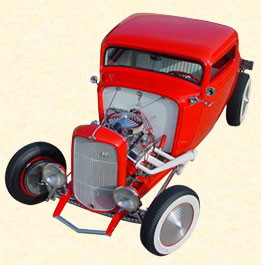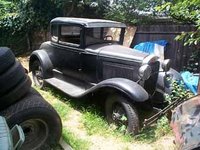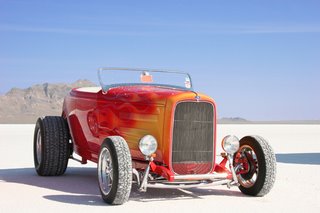Hot Rod Fever

Blandly mother
takes him strolling
by railroad and by river
-he's the son of the absconded
hot rod angel-
and he imagines cars
and rides them in his dreams
xxx- from Wild Orphan by Allen Ginsberg
I was daydreaming about current events while Mrs. Taylor droned on and on about American History, I think, in the middle of an unseasonably warm spring afternoon. This particular dream involved a '32 Ford coupe with 16 coats of hand-rubbed cherry red lacquer, a Chevy V8 engine with dual carbs, fat slicks in the back, laker pipes and moon hubcaps all around. Visions of rolled and pleated white naugahyde danced in my head. My dream car was gestating.
All well and good, as far as dreams go, but I knew it would never go much further. My dream life had become quite active since my father left for California and we ended up in the South End of Albany, on welfare. Life was tough, but dreams were free, and it was a great way to improve upon a badly-designed universe. Not that the Designer was paying much attention, mind you, but I was already working on the rough sketches with pencil and paper. Like many dreamers before me, I was a damn good artist.
When things were coming apart, when the dull and the incomprehensible conspired against me, I could always slip into a chopped and channeled roadster, examine the curves of a 550 Spyder, or catch the gleam in the eye of a radically altered '49 Merc, like the one dad drove away in. There was no reason to hurry in this parallel world; it might take me a whole week of study halls to capture the reflections on a chrome hubcap.
 The angle of a Firestone tire turning into a curve would be studied with the same intensity that Michelangelo contemplated the dome of the Basilica di San Pietro, with the results just as satisfying.
The angle of a Firestone tire turning into a curve would be studied with the same intensity that Michelangelo contemplated the dome of the Basilica di San Pietro, with the results just as satisfying.The stripped-down street rod itself was a work of minimalist art; it was rebellious, dangerous, and sexy; it spoke of power, freedom, individualism and innovation, and like many of America's most enduring cultural icons, it was born in the mythical land of California.
When the war ended in 1945, hundreds of young men returned home with newfound mechanical skills and a burning desire to build their dream cars. In the backyards and garages of Pasadena, Glendale and Burbank, they took things into their own hands and created some of the most innovative machines ever to run a redlight. Although racing them was initially confined to dry desert lakebeds, street racing soon caught on in other parts of the country, and the hot rod became a fixture on the list of America's social problems, right up there with juvenile delinquency and teenage gangs. Like the rock music that blasted from its radio, it quickly became a symbol for the dark side of American youth, and an early sign of the cultural revolution to follow. I was solidly hooked. They were rockin' my dreams.
Then one day I saw an ad in the paper for a 1930 Model A 5-window coupe, selling for a measly one hundred dollars. I didn't have the money to buy it, of course, but I knew where I could get it. Tony Donahue was several years older than us, worked for the New York Central railroad, had a Magnavox hi-fi and an impressive record collection. Needless to say, we spent a lot of time at his house. As a drummer with my own band, I spoke rock'n'roll fluently, and had become his de facto music consultant.
 Since he would usually pick up just about anything I'd recommend, it was, in a sense, my record collection as much as his. I decided to try and parlay this power into a major move into the magical world of hotrodding.
Since he would usually pick up just about anything I'd recommend, it was, in a sense, my record collection as much as his. I decided to try and parlay this power into a major move into the magical world of hotrodding.A few days later I was behind the wheel of a Model A, hooked to the bumper of Tony's '54 Ford Glasstop Victoria, weaving our way through Albany traffic. It was tricky business with a rope. I had to stay completely on top of things in order to hit the brakes as soon as his brake lights went on. At this one intersection, though, somebody pulled out in front of him thinking he had time to stop. The margin of error was very slim; I never even got my foot on the brake pedal before I smashed head-on into his beautiful coral paintjob. We limped the rest of the way to Chris Hoffman's garage, but the damage had been done. If we thought it was going to be difficult to begin building our masterpiece before the accident, it had suddenly become impossible.
The dream didn't die immediately, however. We would regularly gather at the garage for planning meetings, which usually consisted of each of us getting a turn sitting behind the wheel with a Lucky Strike in our mouth, arm resting on the window, rolled-up sleeves and a far away look in our eyes. This lasted a couple of months before we finally gave up the dream and handed the car over to a real master, Bobby Hennig, who eventually turned it into something we could all look at wistfully as it crawled down Elm Street with a low rumbling sound. For me, it was back to the drawing board, where I was already working on a few new dreams.







2 Comments:
Beautiful... I remember... Brings tears to my eyes... Got a Lucky?
Thanks, Bob... a labor of love... Yeah, got a light?
Post a Comment
<< Home